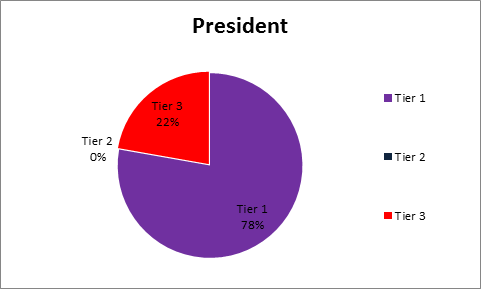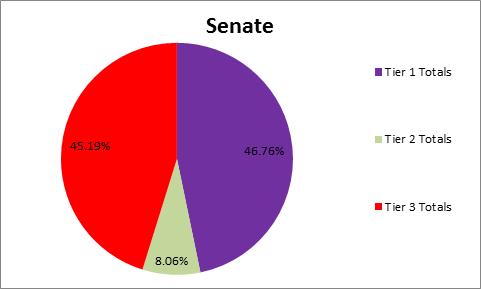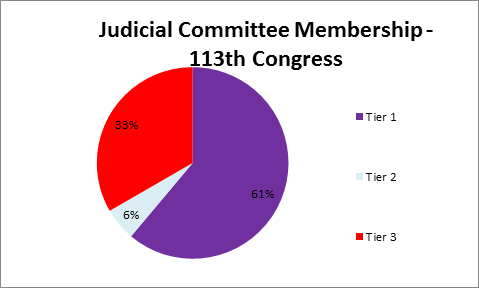The definition of American democracy in its simplest form is a government of the people, by the people, and for the people, and it worked for the nation’s earliest political leaders. Consisting of men who worked the land, they were familiar with the wants and needs of their constituents, and took the matter of government service as a serious duty. The legislative calendar reflected the times as politicians scheduled session breaks to coincide with the planting or harvesting of crops. Times, however, have changed and a popular complaint today is that our leaders are out of touch with the populace, and place corporate welfare above the well-being of the people. The overwhelming cause for this disconnect is education, or more precisely, which college a politician attends.
For most Americans, the cost of college plays a significant role when choosing a school. Higher education is an investment that serves to expand the student’s mind, while also teaching the social skills necessary to make friendships that may last a lifetime. With each new addition to the social network, new opportunities become available for the student, and if seeking a graduate degree, the social network matures to include a smaller network of exceptional friends. However, for some students cost is not a factor, and the choice becomes influenced by a university’s prestige and reputation for providing the student with both a degree and a pedigree. The friendships made while attending one of the nation’s top schools offer exponential benefits to the student via access to social elites, while the school’s reputation bestows an often-undeserved gravitas on its alumni.
Education matters, but to reach the truly preeminent position of presidential, judicial, and senatorial power requires attendance at one of the nation’s top twenty universities. To explore the relationship between education and political power, this analysis divided American higher educational schools into three tier levels using data provided by U.S. News and World Report rankings of National Universities and National Liberal Arts Colleges. The top twenty schools on both lists formed the Tier 1 schools, while schools ranked from 21 to 50 were included in Tier 2 schools. Tier 3 schools included any institution ranked below fifty.
To attend a Tier 1 school in 2014 costs an individual $43k annually with an average student enrollment of 15k in national universities that drops to an average of 2k for liberal arts colleges. A steep price to pay for a smaller class size, the cost of an undergraduate degree from an elite school is $172k and it continues to rise. The students encounter elite private clubs and rub elbows with the next generation of socioeconomic giants, and possibly future powerful contacts.
Further, these contacts make the exorbitant school costs at this level such a worthwhile investment. Narrow the focus to the nation’s top five universities – Princeton, Harvard, Yale, Stanford, and Columbia Universities – and the fiscal benefits of attending one of these institutions becomes apparent with an alumnus that boasts 116 billionaires, according to The Atlantic. Harvard alone counts almost 3000 graduates as worth more than $30 million each. Academically, these schools are staffed with scholars whose studies drive the narrative for the nation’s future. However, the elite atmosphere that insulates these institutions also limits their students and faculties exposure to America’s cultural soup and the economic realities confronting the nation’s denizens. As a result, the scholarship from Tier 1 schools is often focused through a very narrow socioeconomic prism of understanding.
The difference in cost between a Tier 1 school and Tier 2 school is small, with the student on the hook for an average of $39k annually at a national university, and a $42k average annual price tag for attendance at a liberal arts college. Annual average enrollments climbed to 24k at national universities, but maintained the same 2k average found at Tier 1 schools. The increased enrollment signals that Tier 2 national university schools appear more accessible to a larger portion of the American populace, providing greater diversity for its student body, and broader access to opportunities for cultivating economic contacts. The mirror-like averages for Tier 1 and Tier 2 liberal arts schools infers that the colleges in this group also provide a measure of exclusiveness to degree-holding students, thus boosting the perceived value of alumni membership. Ideas, too, flow copiously from the scholars at these universities, bringing with them the possibility of providing the fame necessary to make the leap to teach at a Tier 1 school.
Tier 3 schools are populated by the remaining higher education institutions, with an average annual cost of $22.8k for the student. This is the tier group available to the majority of American families, admitting students based on a sliding scale of costs in relation to their economic conditions. The quality of academic output from scholars at this level also varies too much to generalize because its members are in the process of career expansion or decline. The substance of a degree earned from a member school depends on the student’s willingness to study diligently in the search for knowledge. While Tier 3 contains the vast majority of American colleges, it is the least represented group within the halls of presidential, judicial, and senatorial power.
In the 20th and 21st century, all but four of eighteen American presidents attended Tier 1 schools. The remaining four presidents hailed from Tier 3 schools or possessed no college education, while two members made sweeping changes to the national dialogue about poverty and identity. Lyndon Johnson signed into law the Civil Rights Act of 1964, and advanced the ideology of a Great Society and the War on Poverty that resulted in government supported food assistance and education programs. Without Johnson’s support for black Americans, there is no President Obama. Ronald Reagan, the penultimate presidential hero for modern Republicans, redefined the definition of poverty leading to a reduction in welfare recipients, while arguing for lower taxes on the wealthy that he promised would “trickle down” to the rest of society. Neither, however, attended a Tier 1 school.

The percentage of Supreme Court Justices hailing from a Tier 1 school is 66%, and shows only a moderate fall from that of the presidential numbers. With thirty-seven of the fifty-six justices appointed in the 20th and 21st century coming from Tier 1 schools, this percentage pales in relation to the current number of sitting Supreme Court Justices, with 100% representation. The impact the judicial branch of the government has on its citizens is mighty. Collectively they are the custodians of interpretation of the U.S. Constitution, and the institution’s power was on full display when it expanded the definition of free speech in politics, resulting in a flood of money for campaigning purposes.

Because of the vast numbers of Senators voted into office during the 20th and 21st century, information for this analysis was limited to a fifty year period beginning with the current
Senate members of the 113th Congress and continuing in decade length intervals to include the 108th, 103rd, 98th, and 93rd Classes. In the Senate, there was a greater level of diversity among Senators and their school tier group representation, with almost 47% of its members identifying as Tier 1 school alumni. However, the tilt in numbers remains firmly in the direction of Tier 1 alumni, with Tier 3 school representation hovering at 45% throughout the period. While these numbers point to a greater degree of influence sharing between the tier groups, much of a Senator’s power resides in committee memberships.

Using information from the 113th Congress, power sharing at the committee level appears relatively even between Tier 1 and Tier 3 schools with the exception of three committees – Committee on Rules and Administration, Committee on the Budget, and Committee on the Judiciary. The Committee on Rules and Administration operates to provide credentials and qualifications for Senate members, but it also oversees federal elections for President and Congress. The Tier 1 representation for this committee stands at 57%, or eleven members, while Tier 3 representation was 37%, or seven members. With the power to decide elections, the current trend means a small cadre of schools possesses the ability to influence election outcomes through entrenched ideologies that emanate from these institutions.

The Senate Budget Committee, in a sense, holds the purse strings of the federal government, deciding the general economic plan for the nation’s spending, while also overseeing the Congressional Budget Office, which monitors the federal debt. This committee contained the highest Tier 1 membership of any committee, as it contained 14 senators, or 64%. Senators from Tier 3 schools numbered seven for 32%, a dismally small percentage of members to represent the viewpoint of the average American, particularly in matters of spending. A committee populated by members who earn more in a year that many Americans earn in a lifetime, yet they still claim to understand the harsh economic conditions that embrace the nation’s poorest people.

The final committee with an overwhelming number of Tier 1 schooled senators is the Committee on the Judiciary. Tasked with oversight of amendments to the U.S. Constitution, it also controls the selection process for new federal and Supreme Court justice nominees. With such far-reaching influence over the laws of the land, the decisions made by committee members directly impact the rights of all Americans. Tier 1 representation on this committee is 61%, or eleven senators, while Tier 3 members only number six, or 33%, a paltry accounting from a government organization that purports to be defenders of justice. It is a vision of justice imagined through the narrow filter of the most expensive, socially exclusive higher education institutions, and only slightly ameliorated by the diversity of six Tier 3 senators.

Each senate committee possesses its own form of power. The Rules and Administration Committee influences the election process, the Budget Committee holds sway over the spending of federal monies, and the Judiciary Committee controls the lawmakers and lawmaking processes. However, is it wise to trust these vast powers and the ideology driving them when only a narrow band of schools, the nation’s top twenty institutions, informs their world view? Further, what does the data mean for the average American?
First, unless the average American can afford to invest $368k on education, joining the Supreme Court is virtually impossible, and gaining the presidency becomes a remote possibility. If the percentages were expressed in terms of a successful cancer recovery diagnoses, the average American’s chance of living would be 22% (President) or 23% (Supreme Court), both low enough to begin planning a funeral, unless, of course, cost was no issue for the patient. The only president who served in the last two centuries without a college education was Harry Truman, an anomaly the current statistical trend indicates will not recur anytime soon.
Second, data from the 113th Senate class points to greater opportunities for power sharing, however, to achieve a seat on an influential committee requires the same heavy education investment as that of a President or Supreme Court Justice. The large presence of Tier 1 schooled senators on the Judiciary Committee may influence its preference for choosing like-minded Supreme Court Justices. Anyone familiar with the high court’s nomination process recognizes the penchant toward selecting candidates that conform, while differences in social or economic ideology provide ammunition to attack and dismiss those whose views fall outside mainstream beliefs.
Finally, the accusation leveled by the Occupy Movement, that American political leadership favors the 1% of society, appears valid. The overwhelming representation of Tier 1 schools among the nation’s political elites reinforces an ideology poorly influenced by the economic and social diversity encountered by the average American. These conditions create a self-sustaining ideological loop that equates elitism with intelligence, resulting in political support by Tier 1 educated leadership for policies that appear foreign to its citizens.
A nation that once enjoyed fair representation by its peers, who provided a government of the people, by the people, and for the people, has devolved into a system that instead is of the elites, by the elites, and for the elites. With the rising cost of college tuition, it is a system built to accommodate success, unless you are an average American.





